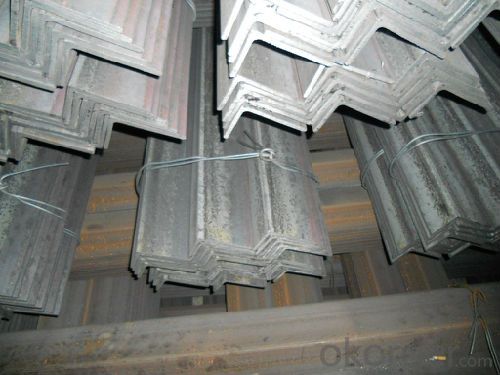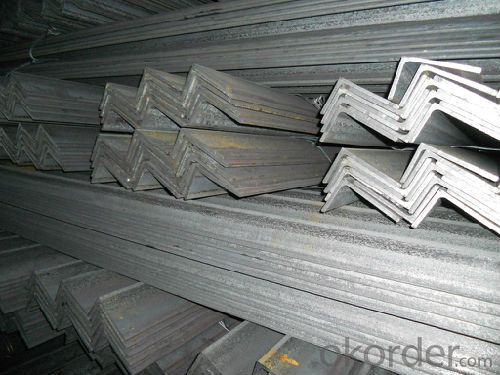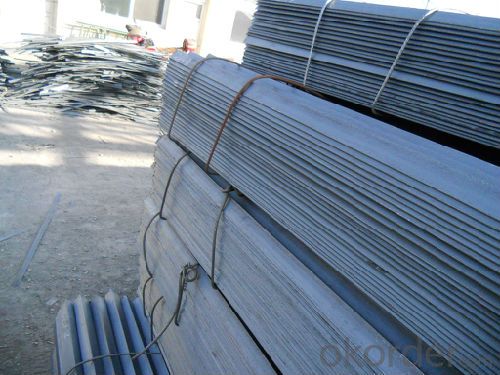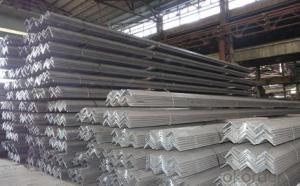Equal Angle Steel, American Standard Steel Angles, Carbon Steel Angle Iron
- Loading Port:
- Tianjin
- Payment Terms:
- TT or LC
- Min Order Qty:
- 25 m.t.
- Supply Capability:
- 35000 m.t./month
OKorder Service Pledge
OKorder Financial Service
You Might Also Like
Product Description:
OKorder is offering Equal Angle Steel, American Standard Steel Angles, Carbon Steel Angle Iron at great prices with worldwide shipping. Our supplier is a world-class manufacturer of steel, with our products utilized the world over. OKorder annually supplies products to European, North American and Asian markets. We provide quotations within 24 hours of receiving an inquiry and guarantee competitive prices.
Product Applications:
Equal Angle Steel, American Standard Steel Angles, Carbon Steel Angle Iron are ideal for structural applications and are widely used in the construction of buildings and bridges, and the manufacturing, petrochemical, and transportation industries.
Product Advantages:
OKorder's Equal Angle Steel, American Standard Steel Angles, Carbon Steel Angle Iron are durable, strong, and resist corrosion.
Main Product Features:
· Premium quality
· Prompt delivery & seaworthy packing (30 days after receiving deposit)
· Corrosion resistance
· Can be recycled and reused
· Mill test certification
· Professional Service
· Competitive pricing
Product Specifications:
1: Galvanized angle
2. Size: 20 x 20 to 200 x 200mm
3. Thickness: 3 to 24mm
4. Length: 5.8/6m,11.8/12m for bulk vessel
Key Specifications/Special Features:
Materials: ASTM A36, A572; Q235, Q345; SS400, Gr.50, EN 10056, S275, S355
Size: 20 x 20 to 200 x 200mm (Special size will be available as per request)
Thickness: 3 to 24mm (special size available as per request)
Length: 5.8/6m,11.8/12m for bulk vessel
Type: Equal
Primary Competitive Advantages:
· Form A
· Guarantee/Warranty
· International Approvals
· Product Features
· Prompt Delivery
· Quality Approvals ISO9001:2000
Application: construction Structural steel
Packaging Details: standard exporting package in bundle
Length*Length*THK(mm) | Weight(kg/m) | Length*length*THK(mm) | Weight(kg/m) |
25*25*3 | 1.124 | 70*70*6 | 6.406 |
25*25*4 | 1.459 | 70*70*7 | 7.398 |
30*30*3 | 1.373 | 70*70*8 | 8.373 |
30*30*4 | 1.786 | 75*75*5 | 5.818 |
40*40*3 | 1.852 | 75*75*6 | 6.905 |
40*40*4 | 2.422 | 75*75*7 | 7.976 |
40*40*5 | 2.976 | 75*75*8 | 9.030 |
45*45*3 | 2.088 | 75*75*10 | 11.089 |
45*45*4 | 2.736 | 80*80*6 | 7.376 |
45*45*5 | 3.369 | 80*80*7 | 8.525 |
50*50*3 | 2.332 | 80*80*8 | 9.658 |
50*50*4 | 3.059 | 80*80*10 | 11.874 |
50*50*5 | 3.770 | 90*90*6 | 8.35 |
50*50*6 | 4.465 | 90*90*7 | 9.656 |
63*63*5 | 4.822 | 90*90*8 | 10.946 |
63*63*6 | 5.721 | 90*90*10 | 13.476 |
63*63*8 | 7.469 | 100*100*6 | 9.366 |
70*70*5 | 5.397 | 100*100*7 | 10.83 |
70*70*6 | 6.406 | 100*100*8 | 12.276 |
Length*Length*THK(mm) | Weight(kg/m) | Length*length*THK(mm) | Weight(kg/m) |
100*100*10 | 15.12 | 160*160*10 | 24.729 |
100*100*12 | 17.898 | 160*160*12 | 29.391 |
110*110*7 | 11.928 | 160*160*14 | 33.987 |
110*110*8 | 13.532 | 160*160*16 | 38.518 |
110*110*10 | 16.69 | 180*180*12 | 33.159 |
110*110*12 | 19.782 | 180*180*14 | 38.383 |
125*125*8 | 15.504 | 180*180*16 | 43.542 |
125*125*10 | 19.133 | 180*180*18 | 48.634 |
125*125*12 | 22.696 | 200*200*14 | 42.894 |
125*125*14 | 26.193 | 200*200*16 | 48.68 |
140*140*10 | 21.488 | 200*200*18 | 54.401 |
140*140*12 | 25.522 | 200*200*20 | 60.056 |
140*140*14 | 29.49 | 200*200*24 | 71.168 |
FAQ:
Q1: Why buy Materials & Equipment from OKorder.com?
A1: All products offered byOKorder.com are carefully selected from China's most reliable manufacturing enterprises. Through its ISO certifications, OKorder.com adheres to the highest standards and a commitment to supply chain safety and customer satisfaction.
Q2: How do we guarantee the quality of our products?
A2: We have established an advanced quality management system which conducts strict quality tests at every step, from raw materials to the final product. At the same time, we provide extensive follow-up service assurances as required.
Q3: How soon can we receive the product after purchase?
A3: Within three days of placing an order, we will begin production. The specific shipping date is dependent upon international and government factors, but is typically 7 to 10 workdays.
Q4: What makes stainless steel stainless?
A4: Stainless steel must contain at least 10.5 % chromium. It is this element that reacts with the oxygen in the air to form a complex chrome-oxide surface layer that is invisible but strong enough to prevent further oxygen from "staining" (rusting) the surface. Higher levels of chromium and the addition of other alloying elements such as nickel and molybdenum enhance this surface layer and improve the corrosion resistance of the stainless material.
Q5: Can stainless steel rust?
A5: Stainless does not "rust" as you think of regular steel rusting with a red oxide on the surface that flakes off. If you see red rust it is probably due to some iron particles that have contaminated the surface of the stainless steel and it is these iron particles that are rusting. Look at the source of the rusting and see if you can remove it from the surface.
Images:



- Q:Can steel angles be drilled?
- Yes, steel angles can be drilled. Steel angles are commonly used in construction and fabrication projects, and drilling holes in steel angles is a common practice. However, drilling steel angles may require specialized drilling equipment, such as a drill press or a high-speed steel drill bit, due to the hardness of the steel. Additionally, using cutting lubricants or coolants during the drilling process can help to reduce heat and extend the life of the drill bit. Overall, with the right tools and techniques, steel angles can be easily drilled to accommodate various construction and fabrication needs.
- Q:Are steel angles suitable for earthquake-resistant construction?
- Indeed, earthquake-resistant construction can make use of steel angles. Steel, known for its strength and ductility, is an ideal material for withstanding seismic forces. Specifically, steel angles are commonly employed in seismic design and construction because of their ability to offer structural stability. Bracing elements in buildings often consist of steel angles, which help withstand lateral forces resulting from earthquakes. These angles can be installed diagonally between structural members, creating a rigid frame capable of effectively absorbing and dissipating seismic energy. By distributing the forces generated during an earthquake, these angles play a crucial role in preventing structural collapse. Moreover, steel angles can be designed and fabricated to meet specific seismic design criteria. Engineers can consider factors such as the building's location, expected seismic activity, and desired level of earthquake resistance. By utilizing advanced computer-aided design and analysis tools, engineers can optimize the placement and size of steel angles, thereby enhancing the structure's overall seismic performance. Apart from their strength and ductility, steel angles offer other advantages for earthquake-resistant construction. They are lightweight, reducing the overall weight of the structure and enabling more efficient seismic design. Additionally, steel is a recyclable material, making it a sustainable choice for construction projects. However, it is important to note that the suitability of steel angles for earthquake-resistant construction relies on various factors, including the specific design, construction techniques, and adherence to building codes and regulations. Professional engineering expertise and thorough analysis are essential to ensure the appropriate utilization of steel angles in seismic design. In conclusion, steel angles are suitable for earthquake-resistant construction due to their strength, ductility, and ability to provide structural stability. When appropriately designed and installed, they can effectively resist seismic forces and contribute to the overall safety and resilience of the structure.
- Q:What are the different methods of surface galvanizing for steel angles?
- There are several methods of surface galvanizing for steel angles, including hot-dip galvanizing, electro-galvanizing, and mechanical galvanizing.
- Q:What are the common methods of surface preparation for steel angles?
- Common methods of surface preparation for steel angles include abrasive blasting, such as sandblasting or shot blasting, to remove rust, scale, and contaminants from the surface. Chemical cleaning can also be used to remove oils, greases, and other organic materials. Additionally, mechanical cleaning methods like wire brushing or grinding can be employed to smooth out rough surfaces and remove any remaining debris.
- Q:What are the different surface treatments for steel angles?
- There are several different surface treatments available for steel angles, each designed to enhance their durability, appearance, and resistance to corrosion. Some of the common surface treatments for steel angles include: 1. Hot-dip galvanizing: This process involves immersing the steel angles in a bath of molten zinc, which forms a protective coating on the surface. Galvanizing provides excellent corrosion resistance and is ideal for outdoor applications where the angles may be exposed to moisture and harsh weather conditions. 2. Powder coating: Powder coating involves applying a dry powder paint to the surface of the steel angles. The angles are then heated, causing the powder to melt and form a smooth, durable coating. Powder coating provides a wide range of color options and improves the angles' resistance to chipping, scratching, and fading. 3. Electroplating: Electroplating involves depositing a layer of metal onto the surface of the steel angles through an electrochemical process. Common metals used for electroplating include zinc, nickel, and chrome. Electroplating provides both aesthetic appeal and enhanced resistance to corrosion. 4. Priming and painting: Priming and painting involves applying a layer of primer followed by a coat of paint to the steel angles. Priming helps improve adhesion and provides a smooth surface for the paint to adhere to. Painting not only enhances the appearance of the angles but also provides some protection against corrosion. 5. Anodizing: Anodizing is typically used for aluminum angles rather than steel, but it can also be applied to steel. This process involves creating an oxide layer on the surface of the angles by subjecting them to an electrolytic process. Anodizing improves the angles' corrosion resistance, hardness, and color stability. It is important to choose the appropriate surface treatment for steel angles based on the specific application and environmental conditions they will be exposed to. Each treatment offers unique benefits in terms of corrosion resistance, aesthetics, and durability, so carefully considering these factors will help ensure the longevity and performance of the steel angles.
- Q:How do you determine the shear capacity of a steel angle?
- The shear capacity of a steel angle can be determined by calculating the shear stress at the critical section, which is typically located at the junction between the web and the flange. This can be done by dividing the applied shear force by the effective shear area, taking into account the material properties and geometric dimensions of the angle. Additionally, design codes and standards provide tables and formulas that can be used to determine the shear capacity of steel angles based on their dimensions and loading conditions.
- Q:What is the typical density of steel angles?
- The typical density of steel angles is approximately 7.8 grams per cubic centimeter.
- Q:What is the typical width of a steel angle?
- The typical width of a steel angle can vary depending on its intended use and the specific requirements of the project. However, in general, steel angles are available in a wide range of sizes and dimensions. Commonly, the width of a steel angle can range from 1 inch to 8 inches or more. It is important to consult the relevant industry standards and specifications to determine the appropriate width for a specific application.
- Q:What are the common uses of unequal steel angles?
- Unequal steel angles are commonly used in construction, engineering, and fabrication projects. They are often used as structural supports, providing stability and strength in frameworks, buildings, and bridges. These angles are also used for creating bracing systems, reinforcing corner joints, and as components in machinery and equipment. Additionally, they are utilized in architectural designs for decorative purposes, adding aesthetic appeal to structures.
- Q:How do steel angles perform in corrosive environments?
- Steel angles typically have good performance in corrosive environments, but their resistance to corrosion depends on the type and grade of steel used. In general, steel angles made from stainless steel or galvanized steel are more resistant to corrosion compared to carbon steel angles. Stainless steel angles contain chromium, which forms a passive layer on the surface that helps protect against corrosion. This makes them highly resistant to rust and other forms of corrosion, even in highly corrosive environments such as saltwater or chemical plants. Galvanized steel angles are steel angles that have been coated with a layer of zinc. This zinc coating acts as a sacrificial barrier, protecting the underlying steel from corrosion. Galvanized steel angles are particularly effective in environments with high humidity or exposure to moisture, as the zinc coating provides excellent corrosion resistance. On the other hand, carbon steel angles are more susceptible to corrosion. Without any protective coating, carbon steel angles can rust and corrode when exposed to moisture or corrosive substances. However, there are various methods to enhance the corrosion resistance of carbon steel angles, such as applying protective coatings or using corrosion inhibitors. In summary, steel angles can perform well in corrosive environments, but the choice of steel grade and protective measures is crucial for their long-term corrosion resistance. Stainless steel angles and galvanized steel angles are generally preferred for their superior corrosion resistance, while carbon steel angles require additional protection to ensure their durability in corrosive environments.
1. Manufacturer Overview |
|
|---|---|
| Location | |
| Year Established | |
| Annual Output Value | |
| Main Markets | |
| Company Certifications | |
2. Manufacturer Certificates |
|
|---|---|
| a) Certification Name | |
| Range | |
| Reference | |
| Validity Period | |
3. Manufacturer Capability |
|
|---|---|
| a)Trade Capacity | |
| Nearest Port | |
| Export Percentage | |
| No.of Employees in Trade Department | |
| Language Spoken: | |
| b)Factory Information | |
| Factory Size: | |
| No. of Production Lines | |
| Contract Manufacturing | |
| Product Price Range | |
Send your message to us
Equal Angle Steel, American Standard Steel Angles, Carbon Steel Angle Iron
- Loading Port:
- Tianjin
- Payment Terms:
- TT or LC
- Min Order Qty:
- 25 m.t.
- Supply Capability:
- 35000 m.t./month
OKorder Service Pledge
OKorder Financial Service
Similar products
New products
Hot products
Related keywords



























